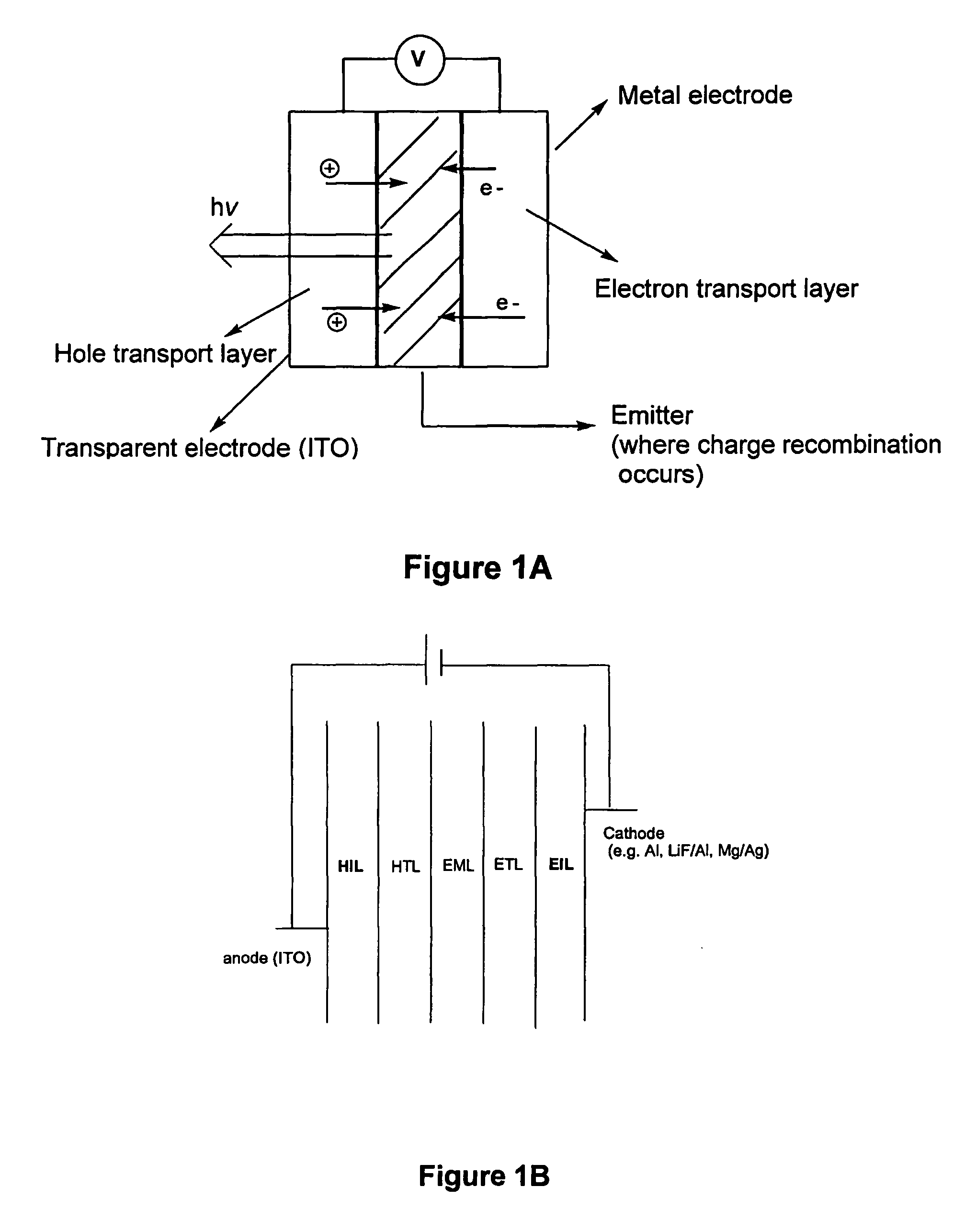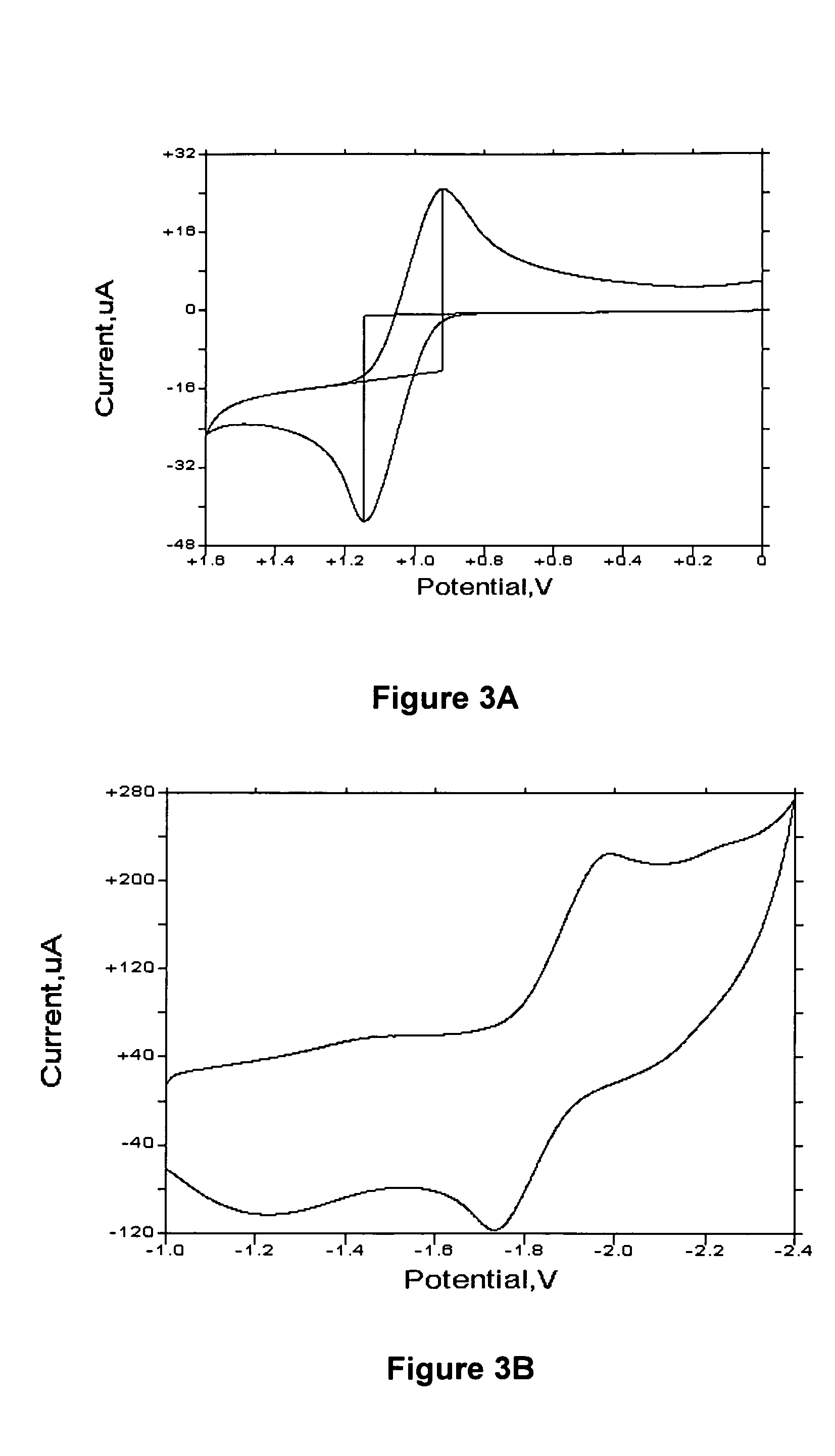Organoboron luminescent compounds and methods of making and using same
a luminescent compound and organic compound technology, applied in the direction of luminescent screen of discharge tube, group 3/13 element organic compound, group 5/15 element organic compound, etc., can solve the problems of limiting the use of the device, forming voids or pinholes, and affecting the efficiency of the device and its thermal stability
- Summary
- Abstract
- Description
- Claims
- Application Information
AI Technical Summary
Benefits of technology
Problems solved by technology
Method used
Image
Examples
working examples
[0245] All starting materials were purchased from Aldrich Chemical Company, Milwaukee, Wis., U.S.A., and used without further purification. Aromatic bromides, p-(2,2′-dipyridylamino)bromobenzene (Kang et al., 2002), p-(2,2′-dipyridylamino)bromobiphenyl (Kang et al., 2002), p-(7-azaindolyl)bromobenzene (Kang et al., 2002), p-(7-azaindolyl)bromobiphenyl (Kang et al., 2002), 3,5-bis(7-azaindolyl)bromobenzene (Wu et al., 2001 and p-(2,2′-dipyridylamino)phenylboronic acid (Jia et al., 2003) were synthesized according to previously reported procedures. Solvents were freshly distilled over appropriate drying reagents. All experiments were carried out under a dry nitrogen atmosphere using standard Schlenk techniques unless otherwise stated. Thin layer chromatography was carried out on silica gel (SiliCycle Inc., Quebec City, Quebec, Canada). Flash chromatography was carried out on silica (silica gel 60, 70-230 mesh) (SiliCycle Inc., Quebec City, Quebec, Canada). 1H and 13C NMR spectra were ...
example 1
Synthesis of p-(1-naphthylphenylamino)-4,4′-biphenyldimesitylborane (BNPB)
[0246] The starting material 4-iodo-4′-(1-naphthylphenylamino)biphenyl was synthesized by a coupling reaction of 4,4′-diodobiphenyl with 1-naphtylphenylamine using Ullmann condensation methods (Belfield et al., 2000, Goodbrand et al., 1999, Paine et al., 1987, Fanta et al., 1974, Koene et al., 1998). To a solution of 4-iodo-4′-(1-naphthylphenylamino)biphenyl (0.497 g, 1 mmol) in diethyl ether (60 mL) was added a hexane solution of n-BuLi (1.6M, 0.69 mL, 1.1 mmol) at −78° C., and the mixture was stirred for 1 h at this temperature. A solution of dimesitylboron fluoride (0.33 g, 90%, 1.1 mmol) in diethyl ether (20 mL) was then added and the reaction mixture was stirred for another hour at −78° C. The reaction mixture was then allowed to come to room temperature slowly and was stirred overnight. The solvents were removed under reduced pressure. The residue was subjected to column chromatography on silica gel (CH...
example 2
Fabrication of Electroluminescent Devices for Evaluation of BNPB
[0247] BNPB is an amorphous solid at ambient temperature. BNPB is highly soluble in organic solvents including hexane, benzene, THF, CH2Cl2, ethanol and DMF. A solution of BNPB readily forms uniform transparent films on glass surfaces and metal oxide surfaces by either dropping the solution directly on the surface, vacuum deposition or spin coating. BNPB can form films readily, hence in the preparation of OLEDs, simple spin casting is possible.
[0248] The unique film forming capabilities of BNPB combined with its ability to be a hole transporter make it an ideal candidate for a hole injection layer (HIL) in an EL device. A hole injection layer which forms a good interface with the ITO increases the efficiency of the device. Most organic molecules do not adequately bind to the inorganic oxide ITO. When the layer that is next to the ITO is not well bonded to it, the EL device may undergo formation of a void in this area ...
PUM
| Property | Measurement | Unit |
|---|---|---|
| Electric charge | aaaaa | aaaaa |
| Current | aaaaa | aaaaa |
| Digital information | aaaaa | aaaaa |
Abstract
Description
Claims
Application Information
 Login to View More
Login to View More - R&D
- Intellectual Property
- Life Sciences
- Materials
- Tech Scout
- Unparalleled Data Quality
- Higher Quality Content
- 60% Fewer Hallucinations
Browse by: Latest US Patents, China's latest patents, Technical Efficacy Thesaurus, Application Domain, Technology Topic, Popular Technical Reports.
© 2025 PatSnap. All rights reserved.Legal|Privacy policy|Modern Slavery Act Transparency Statement|Sitemap|About US| Contact US: help@patsnap.com



